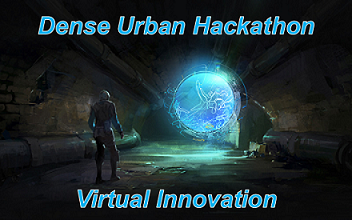[Editor’s Note: The Mad Scientist Initiative’s mission is to connect the intellect of the Nation to the Army and serve as an on-ramp for academia, industry, other Government agencies, and citizens at large to share their ideas and innovations. We’ve found crowdsourcing — the gathering of ideas, thoughts, and concepts from a widespread variety of interested individuals — to be an extremely valuable tool in helping us accomplish this mission; diversifying our thoughts and challenging our assumptions. To that end, Mad Scientist was pleased to continue our enduring partnership with the National Security Innovation Network in exploring solutions to problems in Dense Urban Environments last year. “Seeing into the Unknown – A hackathon exploring situational awareness in dense urban environments” helped the Army identify new and novel ways for Soldiers to see inside buildings, subterranean areas, and other obfuscating structures. Read on to learn about the innovations and unexpected insights we gleaned from this extremely successful collaborative endeavor!]
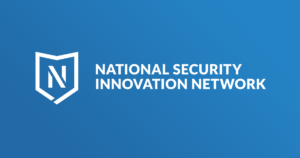 During the summer of 2020, Mad Scientist partnered with the National Security Innovation Network (NSIN) to execute a virtual hackathon centered on solving situational awareness problems in Dense Urban Environments (DUE). Hackathons are great ways to connect with innovators, thinkers, and creators to crowdsource cutting edge and outside-the-box solutions. For this hackathon, we asked the teams to generate novel concepts and solutions for
During the summer of 2020, Mad Scientist partnered with the National Security Innovation Network (NSIN) to execute a virtual hackathon centered on solving situational awareness problems in Dense Urban Environments (DUE). Hackathons are great ways to connect with innovators, thinkers, and creators to crowdsource cutting edge and outside-the-box solutions. For this hackathon, we asked the teams to generate novel concepts and solutions for 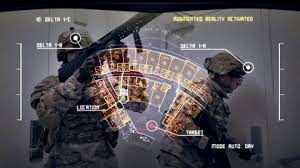 sensing (e.g., detecting, measuring, mapping, monitoring) interior spaces, transmitting this data, and providing an understanding of the dense urban environment to first responders and operators. The teams were asked to focus on several key areas of the problem: detecting physical characteristics and activity, delivering the data in a usable and timely manner, and displaying actionable information to decision-makers.
sensing (e.g., detecting, measuring, mapping, monitoring) interior spaces, transmitting this data, and providing an understanding of the dense urban environment to first responders and operators. The teams were asked to focus on several key areas of the problem: detecting physical characteristics and activity, delivering the data in a usable and timely manner, and displaying actionable information to decision-makers.
The event brought together over 300 virtual participants from academia, defense, start-ups, and early stage ventures. In the end, that group was narrowed down to eight finalists, and eventually three winners that earned $15,000 in contract funding to further develop their ideas. While the objectives of the hackathon were fulfilled, and many early technology solutions were identified, the event also brought to light several key insights that will help the Army now and in the future:
Many technology trends that Mad Scientist tracks were featured prominently throughout the event. Artificial intelligence (AI)/Machine Learning (ML)/autonomy, robotics, sensors, and the civilian Internet of Things (IoT) were all at the forefront of the finalists’ solutions and most, if not all, of the participants’ submissions. What’s clear is that operators in DUE will need synthetic assistance and the convergence of many technologies to carry out successful missions. To gain situational awareness, a sensor or suite of sensors needs to access an unseen area, and robots or Unmanned Systems (UxS) – varying in size, shape, and locomotion – will be the best way to get 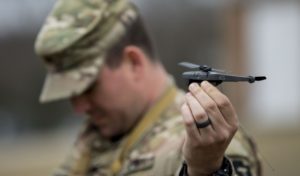 them there. Legged robots will traverse corridors and climb stairs, whether controlled remotely or autonomously, while unmanned aerial systems can fly through windows or bypass stairs to strategically emplace or act as sensors themselves. AI and ML will process the information coming back and highlight the most relevant pieces for visualization to the operator. Reducing cognitive overload and providing a clear and easy to understand picture is imperative and all of the finalists emphasized that importance. In the end, the goal is to provide situational awareness to the operator and augment commanders’ decision making.
them there. Legged robots will traverse corridors and climb stairs, whether controlled remotely or autonomously, while unmanned aerial systems can fly through windows or bypass stairs to strategically emplace or act as sensors themselves. AI and ML will process the information coming back and highlight the most relevant pieces for visualization to the operator. Reducing cognitive overload and providing a clear and easy to understand picture is imperative and all of the finalists emphasized that importance. In the end, the goal is to provide situational awareness to the operator and augment commanders’ decision making.
Public-Private collaboration is not only possible, it can be easy and effective. In order to modernize and keep up with the pace of technological change, the Government will have to look to the private sector and academia. These partnerships will prove vital. As innovation has shifted to industry for  the past several decades, access to these groups can be difficult as government regulations and red tape can be stifling. This virtual hackathon showed that the Government can attract the best and brightest to extract tangible technology solutions while having a free and open dialogue / exchange of ideas. In addition to the 300 participants that took part in the event, eight finalists were identified. The Army now has a strong relationship with a group of innovative technology developers that it didn’t have before.
the past several decades, access to these groups can be difficult as government regulations and red tape can be stifling. This virtual hackathon showed that the Government can attract the best and brightest to extract tangible technology solutions while having a free and open dialogue / exchange of ideas. In addition to the 300 participants that took part in the event, eight finalists were identified. The Army now has a strong relationship with a group of innovative technology developers that it didn’t have before.
A hackathon can answer questions you didn’t know you were asking. This event posed a very specific question to the participants and asked them to focus on a very narrow objective. But innovation and ideation don’t happen in a rigidly constrained environment. In addition to the solutions that were picked as finalists and winners, there were several other teams that provided technology solutions to problems in DUE that could help warfighters today but didn’t strictly align with the hackathon’s objectives. The Army never would have been privy to these ideas without the creative catalyst provided by the 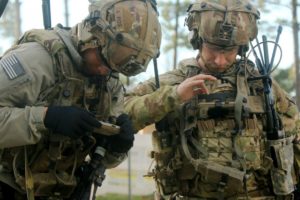 hackathon. Ideas like small, cheap, and quickly deployable but robust ad hoc networks or improvements to computer vision for self-driving vehicles are but two of the innovative ideas that emerged. These have real value and application to other organizations within the Army.
hackathon. Ideas like small, cheap, and quickly deployable but robust ad hoc networks or improvements to computer vision for self-driving vehicles are but two of the innovative ideas that emerged. These have real value and application to other organizations within the Army.
Further, this hackathon really helped us breakdown and understand the DUE situational awareness problem in a more granular fashion. The solutions presented showed us that the larger problem consists of four different subsets: access, sensing, transmitting, and displaying, and each finalist addressed one or some of them. The onus is now on the Army to ultimately discern how best to combine them and create a solution that solves the overarching problem.
Hackathons can make a murky future slightly clearer. Among the myriad of ideas presented are weak signals that can help vector us in the right direction for the future. While it’s foolish to predict the future, we can narrow it down to a range of potential possibilities, and analyzing the ideas from this event can help us confirm we’re on the right track or highlight where we might be going wrong. As previously stated, our interest in AI/ML, autonomy, IoT, UxS, and robotics seems to be grounded in reality. All of these technologies were instrumental in the best solutions. It also confirmed to us that the Radio Frequency (RF) spectrum and connectivity are going to be vital in the future. Most solutions featured a remote sensing technology that transmitted data back to the operator or receiver. In a denied or degraded RF environment, information processing or visualization would be impossible. Knowing what is at stake, we can make decisions now to protect and harden our communications infrastructure for the future. This foresight will also allow us to begin altering our training and education to focus on man-unmanned teaming, trust in AI and autonomy, and network configuration. 
This hackathon demonstrated the effectiveness of inter-governmental cooperation, outreach to academia and industry, and the value and efficiency that can be achieved quickly and cheaply. Innovation is difficult foster, and government access to innovators can be challenging, but virtually connecting the intellect of the Nation to the warfighters, researchers, technology developers, and decision-makers who need their help doesn’t have to be.
If you enjoyed this post, learn more about each of the eight hackathon finalists’ and three winners’ submissions…
… explore the role technological convergences will play in the Operational Environment:
Estimation of Technological Convergence by 2035, and the associated final report and briefing slides, by Lt Col Nicholas Delcour (USAF), Lt Col Louis Duncan (USAF), Mr. Stephen Frahm (DOS), CDR Patrick Lancaster (USN), and Lt Col Lance Vann (USAF), collectively known as the Army War College’s Mad Scientist Fellows of 2020, under the direction of Prof. Kristan Wheaton, U.S. Army War College
Proclaimed Mad Scientist Dr. Jamie Canton‘s presentation on Convergence of Future Technology [watch via a non-DoD network] from the Mad Scientist Robotics, Artificial Intelligence, & Autonomy Conference at Georgia Tech Research Institute, Atlanta, Georgia, 7-8 March 2017
Speed, Scope, and Convergence Trends
Table of Future Technologies: A 360 Degree View Based on Anticipated Availability and the associated Table of Future Technologies, created by Richard Buchter
… read about the challenges of military operations in DUE:
Content from the Current and Future Operations in Megacities Conference, 16-19 July 2019 in Tokyo, Japan; the Multi Domain Battle (MDB) In Megacities Conference, 3-4 April 2018 at Fort Hamilton, New York, and the Megacities and Dense Urban Areas Conference, 21-22 April 2016 at Arizona State University, Tempe, Arizona. Videos of the presentations from each of these conferences may be accessed [via a non-DoD network] here, here, and here, respectively.
Dense Urban Environments (DUE): Now through 2050
TRADOC Pamphlet 525-92-1, The Changing Character of Warfare: The Urban Operational Environment
Military Implications of Smart Cities, by Alexander Braszko, Jr.
Warfare in the Parallel Cambrian Age, by Chris O’Connor
Integrated Sensors: The Critical Element in Future Complex Environment Warfare, by Dr. Richard Nabors
… and listen to the following podcasts, hosted by our colleagues at Modern War Institute:
The Battle for Mosul, with COL Pat Work
The Future Urban Battlefield, with Dr. Russell Glenn
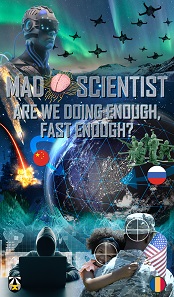 >>> REMINDER 1: Mad Scientist is pleased to announce our new series of monthly virtual events – Are We Doing Enough, Fast Enough? – exploring our adversaries’ views on Competition, Crisis, Conflict, and Change. Join proclaimed Mad Scientists Dr. T.X. Hammes and Dr. Sean McFate, and Dr. David Kilcullen as they address the Operational Environment and Conflict Over the Next Decade, our initial webinar in this new series of events, next Tuesday, 19 January 2021 (1000- 1100 EST). Register here via a non-DoD network to participate in this informative event!
>>> REMINDER 1: Mad Scientist is pleased to announce our new series of monthly virtual events – Are We Doing Enough, Fast Enough? – exploring our adversaries’ views on Competition, Crisis, Conflict, and Change. Join proclaimed Mad Scientists Dr. T.X. Hammes and Dr. Sean McFate, and Dr. David Kilcullen as they address the Operational Environment and Conflict Over the Next Decade, our initial webinar in this new series of events, next Tuesday, 19 January 2021 (1000- 1100 EST). Register here via a non-DoD network to participate in this informative event!
>>> REMINDER 2: We have launched our Mad Scientist Writing Contest on Competition, Crisis, Conflict, and Change to crowdsource the intellect of the Nation (i.e., You!) regarding:
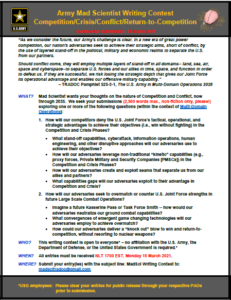
How will our competitors deny the U.S. Joint Force’s tactical, operational, and strategic advantages to achieve their objectives (i.e., win without fighting) in the Competition and Crisis Phases?
How will our adversaries seek to overmatch or counter U.S. Joint Force strengths in future Large Scale Combat Operations?
Review the submission guidelines on our contest flyer, then get cracking brainstorming and crafting your innovative and insightful visions! Deadline for submission is 15 March 2021.
Disclaimer: The views expressed in this blog post do not necessarily reflect those of the Department of Defense, Department of the Army, Army Futures Command (AFC), or Training and Doctrine Command (TRADOC).

